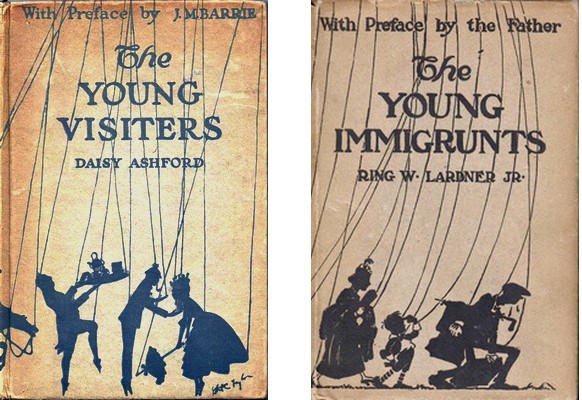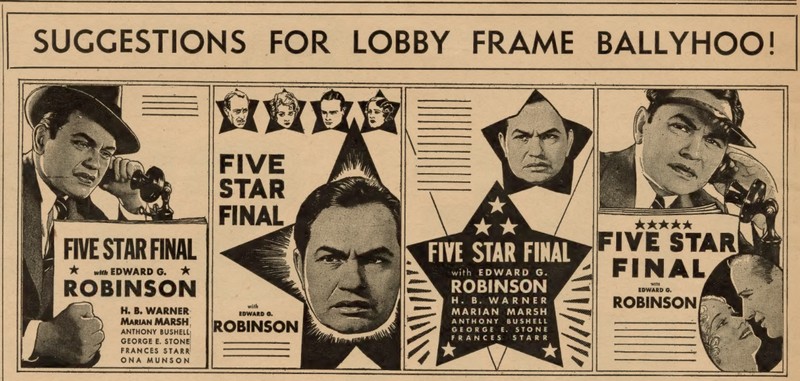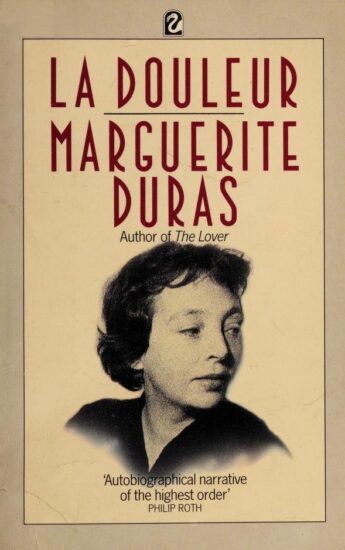
In March 1928, just weeks before Viña Delmar’s first novel, Bad Girl, was published, Boston’s self-appointed censors, the Watch and Ward Society, announced that it disapproved of the novel and threatened to prosecute any Massachusetts shop that sold it. Aside from noting that “The book has one pretty strong chapter in it,” the society provided no justification for the decision, simply stating, “We care neither to push out such books, nor to furnish our contemporaries over in New York with just so much free advertising.”

The story was then rippled through newspapers around the country, providing Delmar and her publisher, Harcourt, Brace and Company with “just so much free advertising,” and Bad Girl the book — and Bad Girl, the 1931 based on it — gained a reputation as a scandalous it hardly deserves. In reality, Bad Girl is no more shocking than Theodore Dreiser’s An American Tragedy: what both books are is unadorned realism. But I’m saying this from today’s perspective. An American Tragedy was also blacklisted by the Watch and Ward Society, and the contemporary sense of what was and wasn’t acceptable among “good people” is of crucial importance to both the title and dramatic pivot of Delmar’s novel.
Dot Healey and Eddie Collins meet one Sunday on a Hudson River cruise, an excursion boat full of working-class couples and singles enjoying an afternoon out of the city. She is a typist; he repairs radios at a store. At first resistant to her flirting, Eddie ends up walking Dot home at the end of the day. But When they arrive back at the apartment building where Dot lives with her widower father and brother, she panics.
“I can’t go upstairs. It’s half past twelve and my brother will kill me.” The last few words were accompanied by an agonized sob.
“Don’t be crazy,” said Eddie, his face suddenly hardening. “Your brother won’t kill you. Tell him you were at a friend’s house. Don’t he know Maude? He won’t holler.”
“Oh, he will, he will, Eddie. He hit me once something awful just because I went to Coney Island and didn’t get home till twelve.”
Dot’s brother is another self-appointed censor, but one filled with righteous violence. Dot continues to see Eddie, until one night she agrees to sleep with him, knowing this will earn her brother’s scarlet letter.
She said what was on her mind. “I’d be a bad girl.”
“No, you wouldn’t. A bad girl is something different. You’d never let anybody else touch you, would you?”
“I don’t know,” she said after a minute’s hesitancy. “I never thought I would let you go the whole way with me.”
This time, when the two return to Dot’s building, she feels that she bears the mark of her sin like a stigmata. Eddie suggests they get married the next day, but Dot knows this will not assuage his fury. “Oh, Eddie, Eddie, I can’t bear it. He’ll see it on me. He’ll know what I’ve done and he’ll kill me.” Dot’s brother doesn’t kill her, but he does banish her, at first even threatening to withhold all her clothes and other belongings: “You touch nothing that’s in that room, hear me? I paid for every damn rag you own,” he declares, adding that, “If you haven’t any money you can probably get some before morning.” Dot spends the night with a friend and in the morning, she and Eddie marry.
From this point on, Bad Girl becomes not a tale of drinking, wild parties, and late-night debauchery but something more like Neil Simon’s Barefoot in the Park: a story of two fairly ordinary young people in their first year or so of marriage. Eddie refuses to let Dot continue working; she grows frustrated with trying to fill her days while he’s at work; she wishes for more space, nicer furniture, more clothes; he struggles to empathize with her feelings; they both worry about money.
Some critics complained that Bad Girl is too full of mundane details of Dot and Eddie’s life. Delmar argued that she wrote about what she knew:
I have been asked if Dot and Eddie, my leading characters, are actual people. The answer is “Yes and no.” Dot and Eddie are the backbone of up-town New York. They are the representative middle-class couple as I see them. These two people are not literally numbered among my acquaintances but Dot and Eddie are the composite picture of a score of my acquaintances. I love them for their naiveté and simplicity and I wrote about them because I want other people to know them.
Delmar’s own life, at least up to the time she started getting her stories published, wasn’t that different from Dot’s. She was born in Brooklyn in 1903, followed her parents, vaudeville performers, around the US, then settled with her father in Harlem after her mother died in 1916. She attended New York City public schools, dropped out of high school to work as a typist, married at the age of 18.
Dot becomes pregnant and the second half of the novel focuses on her experience of pregnancy. She worries about the financial burden of delivery and raising the child, wonders whether Eddie will only see it as a burden, too. I recently read Mary McCarthy’s novel The Group, which follows a number of Vassar graduates through the 1930s, and Bad Girl parallels the gynecological and obstetrical experiences that earned McCarthy’s book its own scandalous reputation (and bestseller status) thirty years later, though recounted — again, with Dreiserian realism — through Dot’s naive and inarticulate perspective.
A friend refers Dot to an abortionist, but the squalor of his office puts her on edge: “The rug needed sweeping, Dot noted after a time. Another few minutes passed before she observed the huddled wisps of dust clinging together beneath the divan. Then she saw other things. Dirty windows, a smeared mirror. She shuddered. There was a damp chilliness about the room.” His unctuous manner further unsettles her. “I like to help little girls out,” he says, and he examines her with “adventurous and heavy” hands.
Like McCarthy’s Priss, Dot is treated with condescension when it comes time to deliver, her child brought in and taken away when the nurses choose, with few explanations or attempts to calm her anxiety when the baby fails to thrive at first. Delmar wrote from experience, having given birth to her son Gray at a Harlem maternity clinic three years before. Given prevailing attitudes towards detailed discussions of pregnancy and childbirth — the word “pregnant” was forbidden in Hollywood scripts and no expectant mother was allowed to show the slightest hint of a bulge — it may well have been Delmar’s frank and detailed account of delivery and postnatal care that set off the Watch and Ward Society.
Ironically, one of the most enthusiastic reviews of Bad Girl appeared in Hospital Management magazine, which praised Delmar for:
Her picture of a devoted and skillful obstetrician, his associate, the sinister other kind which blots the profession, the attitudes of her friends, and her own physiological and psychological reactions in pregnancy, these are of certain value. The careful hoarding for hospital expense and doctor, the impressions of admission and reactions of nurses in attendance, the agony of suspense over the feeding of the child are realism in hospital affairs that should be of immediate interest to physicians, superintendents and nurses.
And though the book became one of the top five bestselling novels of 1928, a book, in the words of one critic, “that the good housewives smuggle into their homes, and discuss furtively over their back fences,” it was consistently acclaimed for its unadorned realism. “It is one of the most matter-of-fact, simple, straightforward, accurate pieces of writing I have ever seen in print,” wrote Joseph M. March in the New York Evening Post, “and it lives from beginning to end.”

The success of Bad Girl boosted Viña Delmar into the ranks of America’s most popular writers. The year after it came out, the first film adaptation of her work, Dance Hall, based on her short story of the same name, was released by RKO, and Playing Around, based on “Sheba,” followed in 1930. The same year, Delmar and Brian Marlowe wrote a play based on Bad Girl that toured the country, although its Broadway run was brief. The novel wasn’t filmed until 1931, but the movie benefited significantly from a convergence of talents, particularly director Frank Borzage, who was becoming an expert in stories of the working-class, and actors Sally Eilers and James Dunn, paired in the first of six films they would make together.
Dunn, who grew up in the same neighborhood as Delmar, hit the screen in a starring role with his first feature and his unfiltered Noo Yawk accent provided a refreshing alternative to the mid-Atlantic accent that had become the studio’s preference. The Los Angeles Times wrote that “no performance has lately equaled the impression made by this rather plain young man, who, aside from having a likable personality, scores a major hit by his ability as an actor.” Few reviewers found anything scandalous in the film, and William A. Johnston of the Hollywood Herald gushed that, “The Fox people have glorified a theme that hits at the heart of the youth of America: pulsing, human, wholesome, in the finale, uplifting…laid against the background of modern big city life, brutal in its realism, yet wholly unobjectionable in detail.” “Let the censors and their scissors go hang!” Johnston declared.

Still, when it came time to market the film, the emphasis was on scandal over substance. “There’s one in every town,” declared a two-page ad published in several industry journals, showing a much more alluring Dot than appears in either the novel or the movie. Another ad featured Delmar’s novel, calling it an “emotional exposé.” The title Bad Girl is almost deliberately misleading, but perhaps that’s what Delmar had in mind all along.

Critics and industry insiders, however, recognized the merits of Bad Girl. It was named to several lists of the ten best films of the year and was nominated for five Academy Awards, winning two, for director Frank Borzage and screenwriter Edwin J. Burke. A dozen of Delmar’s magazine stories were made into films and she herself wrote the screenplays for two of the best American movies of the 1930s, Make Way for Tomorrow and The Awful Truth.










































 David Quantick is a writer with seven novels and over a dozen nonfiction books to his name. His most recent novel, Ricky’s Hand, was published in August 2022. You can find out more at
David Quantick is a writer with seven novels and over a dozen nonfiction books to his name. His most recent novel, Ricky’s Hand, was published in August 2022. You can find out more at 




















 Sarah Lonsdale is a journalist, critic and author. Her latest book, Rebel Women Between the Wars: Fearless Writers and Adventurers (MUP, 2020) investigates how women in the 1920s and 30s overcame social and political obstacles in a range of occupations including mountaineering, engineering and foreign correspondence. She lectures in history and journalism at City, University of London.
Sarah Lonsdale is a journalist, critic and author. Her latest book, Rebel Women Between the Wars: Fearless Writers and Adventurers (MUP, 2020) investigates how women in the 1920s and 30s overcame social and political obstacles in a range of occupations including mountaineering, engineering and foreign correspondence. She lectures in history and journalism at City, University of London.